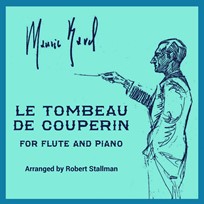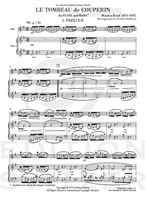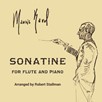
Le Tombeau de Couperin
Composer: Maurice Ravel
Instrument: Flute and Piano
Level: Advanced
Published: 2016
Price: €30.00
Item details
-
Description +
-
Arranged by Robert Stallman
Duration: 18 min.
... Ravel’s return to music began with Le Tombeau de Couperin, started in 1916 and completed a year later. Organized as a French baroque suite in six dance movements, Le Tombeau (“Homage”) is indirectly inspired by François Couperin’s harpsichord music, for which Ravel held a special fondness. (He had often heard Wanda Landowska play Couperin on her two-manual Erard harpsichord.) Each movement is dedicated to a fallen friend of World War I; yet in tone Le Tombeau is actually more cheerful than austere. This dance suite presents the restrained elegance and formality of the French Baroque, juxtaposed with Ravelian harmonic and melodic treatment. Ravel himself called the work “un adieu dans un sourire” (“a farewell tucked into a smile”) ...
-
-
Instrumentation +
-
Flute and Piano
-
-
Watch+
-
About the composer +
-
Joseph Maurice Ravel (7 March 1875 – 28 December 1937) was a French composer, pianist and conductor. He is often associated with impressionism along with his elder contemporary Claude Debussy, although both composers rejected the term. In the 1920s and '30s Ravel was internationally regarded as France's greatest living composer.
Born to a music-loving family, Ravel attended France's premier music college, the Paris Conservatoire; he was not well regarded by its conservative establishment, whose biased treatment of him caused a scandal. After leaving the conservatoire Ravel found his own way as a composer, developing a style of great clarity, incorporating elements of baroque, neoclassicism and, in his later works, jazz. He liked to experiment with musical form, as in his best-known work, Boléro (1928), in which repetition takes the place of development. He made some orchestral arrangements of other composers' music, of which his 1922 version of Mussorgsky's Pictures at an Exhibition is the best known.
As a slow and painstaking worker, Ravel composed fewer pieces than many of his contemporaries. Among his works to enter the repertoire are pieces for piano, chamber music, two piano concertos, ballet music, two operas, and eight song cycles; he wrote no symphonies or religious works. Many of his works exist in two versions: a first, piano score and a later orchestration. Some of his piano music, such as Gaspard de la nuit (1908), is exceptionally difficult to play, and his complex orchestral works such as Daphnis et Chloé (1912) require skilful balance in performance.
Ravel was among the first composers to recognise the potential of recording to bring their music to a wider public. From the 1920s, despite limited technique as a pianist or conductor, he took part in recordings of several of his works; others were made under his supervision.
-
-
Credits +
-
Front Cover graphics and layout: Gaia Gomes
Photo of Robert Stallman: Lisa Kohler
Engraving: Ary Golomb
Drawing of Ravel (artist unknown), courtesy of Robert Stallman
Printed in Copenhagen, Denmark
Copyright © Edition SVITZER
www.editionsvitzer.com
-









